So here we are inside of February already. And this is the shortest month of the year with either 28 or 29 days only. Next year is a leap year, by the way, if you have anything you would like to plan for.
Now February was one of the last two months to be added to the calendar by the Romans, at one time you just had November, December, and Winter, which lasted until March. And strangely the first month of the year at that time was March. When January and February came along, January stole the title of being the first month of any year.
One thing to look out for this week is the full moon, which has the rather alarming name of the snow moon. And yes, the name does refer to the fact that there is often a cold snap around that time. It is on February 5th.
Anyway, lets get on with it!

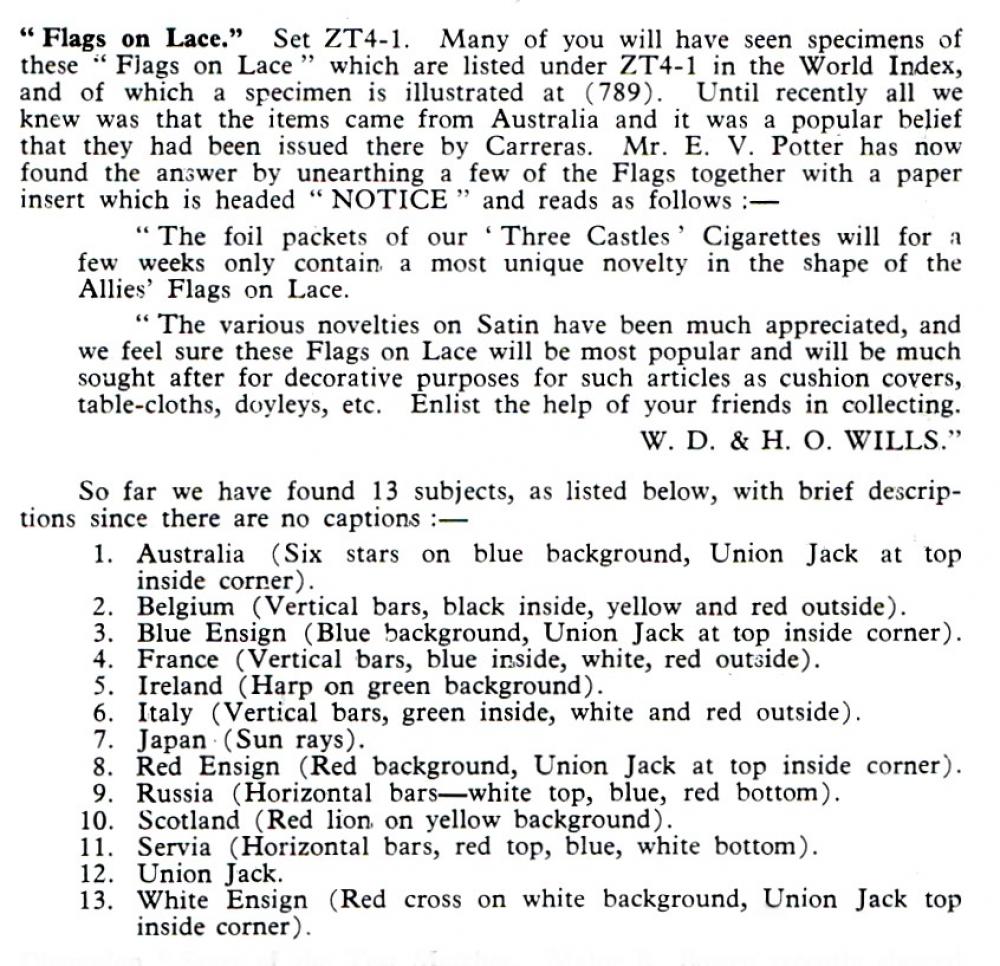
To mark National Lace Day I thought we could have some fun finding out about this curious set. The scan of the actual flag at the top has been supplied to us by a kind reader, whilst the scan below is extracted from the Cartophilic World magazine of May-June 1962 (Vol.14 No.159). The curious thing is that not much more seems to have been discovered. But maybe someone out there can help?
In the original World Tobacco Issues Index the set was listed in the back of the book as ZT4.1 under miscellaneous items as "Flags on Lace, Issued in Australia" but without any idea of an issuer. I am not sure when the "popular belief" that these items had been issued in Australia by Carreras came from, but it must have had more than a bit of support for them to be able to say that it was a "popular belief".
The mention of Mr. Potter and his Three Castles clipping mentioned in the piece seems certainto have settled the matter of Wills being the issuer - but when the World Tobacco Issues Index was reworked and issued in the year 2000 the set again appears at the back of the book and as ZT04-250. It also says "72 x 50 m/m Unn`d set of 13 issued in Australia probably by BAT."
So where has the Wills connection gone?
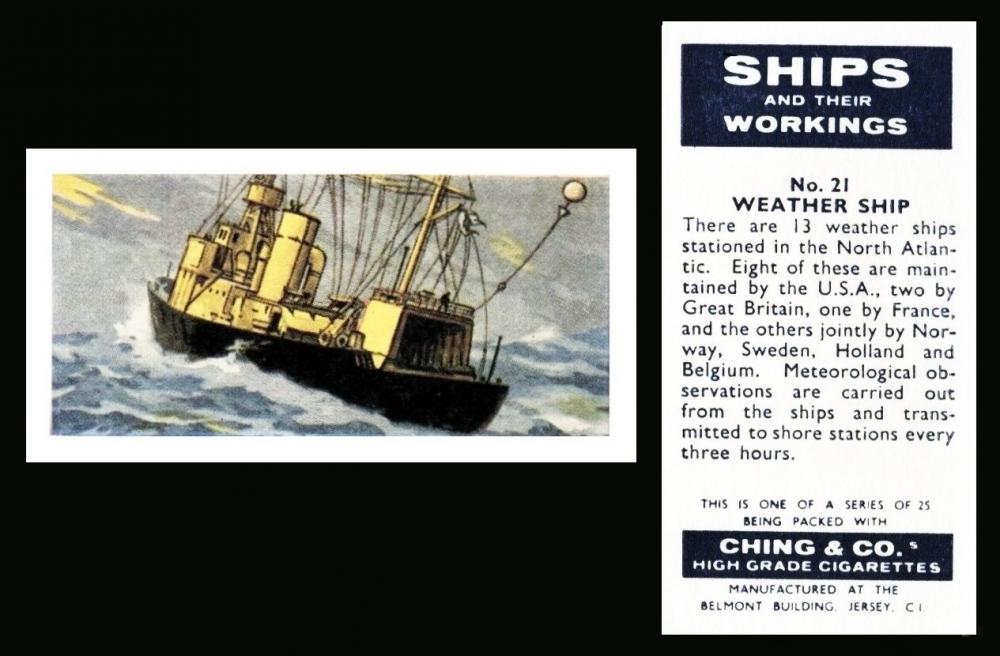
Ching & Co. [tobacco : UK] "Ships and their Workings" (1961) 21/25 - C440-760 .
Here we have an intriguing card for today`s National Weather Person`s Day. This ship was one of thirteen which used to roam the North Atlantic bringing us the weather.
When we think of a weather person today bringing you live satellite links from around the globe, we forget that at one time their job was hazardous.
This set does not appear in our original World Tobacco Issues Index simply because it was issued after that had been published. The one code above comes from our modern version issued in the year 2000. And that tells us that the cards measure 68 x 36 m/m
Now we have found something rather curious courtesy of a very interesting website called Ocean Weather Ships - if you scroll down you find this card but with a different back, for Dunhills of Pontefract. The text and top box is the same as our card. But Dunhills were trade, and made confectionery, Pontefract Cakes to be exact, those curious liquorice chews that are so associated with that area.And an early maker was one George Dunhill, who was not only growing it and making it by 1750, but who also changed it forever when he added an ingredient never used before, and that was sugar. I cannot imagine how awful it must have been without sugar, it is not to my liking with it! But this Dunhill predates the Alfred Dunhill famed for making pipes and tobacco, and by some way, for that Alfred Dunhill first set up shop in 1907.
Turns out this mention adds quite a bit to our knowledge - for when I look in the British Trade Index part 2, I find that the Dunhill set is listed under DUH-1, and the set was issued in 1962. It measures 68 x 36 m/m and is a numbered set of 25 cards. Then it says "See D376" which means the back of the book where alike series usually go. This tells us that not only was the set issued by Ching, our featured card, and the new discovery Dunhill, but it was also issued by Booth, and Clover Dairies.
And it tells us something else which I find very fascinating, and that is a code for Ching. This code is given as C76.3-5. But when I look in the World Tobacco Issues Index this code is not there. The listings jump from C76.1 China Yue Shing Tobacco Co. Ltd to Chong Sing Tobacco Co at C77-1 to C77-4. So there must have been an interim listing some time?
Anyway E. H. Booth is listed as tea and coffee, with branches in Blackpool, Blackburn, Kendal, Preston, Southport, St. Annes on Sea. They issued this set in 1971
Clover Dairies Ltd has no address given but they also issued this set in 1971. It turns out that they started in Grimsby in the 1920s.
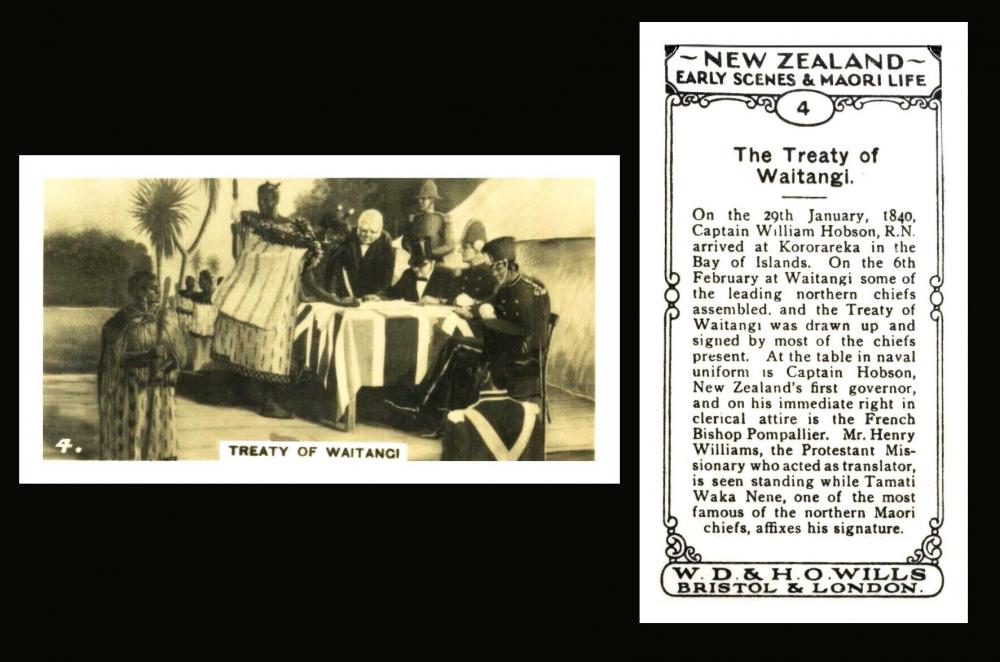
W.D. & H.O. Wills [tobacco : UK] "New Zealand Early Scenes and Maori Life" (August 1926) 4/50 - W675-661 : W62-459 : W/274 : RB.21-200-274A
To mark Waitangi Day in New Zealand we have this representation of the actual scene when William Hobson signed the treaty with the Maori.
This card is obviously not a photograph from the actual event and I believe it either comes from a re-enactment or is an artist`s impression. I also think that image could have been previously used as a postcard, but have not been able to track it down yet. This is supported by the fact that it is called a "photoprint" rather than a photograph in our Wills reference book part 4, where it says ":fronts glossy photoprints in black and white. Backs in black with descriptive text. New Zealand Issue 1925-30"
However by the time of the World Tobacco Issues Index in 1956 this reference has disappeared and it simply says "Sm. B & W photos. Nd. (50)". However it does give us the RB.21 reference, which is the original British American Tobacco booklet, and that tells us of an anonymous variation, with a plain back, which it gives the letter (B), making our set (A). This variant seems to have been forgotten by the time of our updated World Tobacco Issues Index, so it could have been found to simply be a cut up proof sheet.
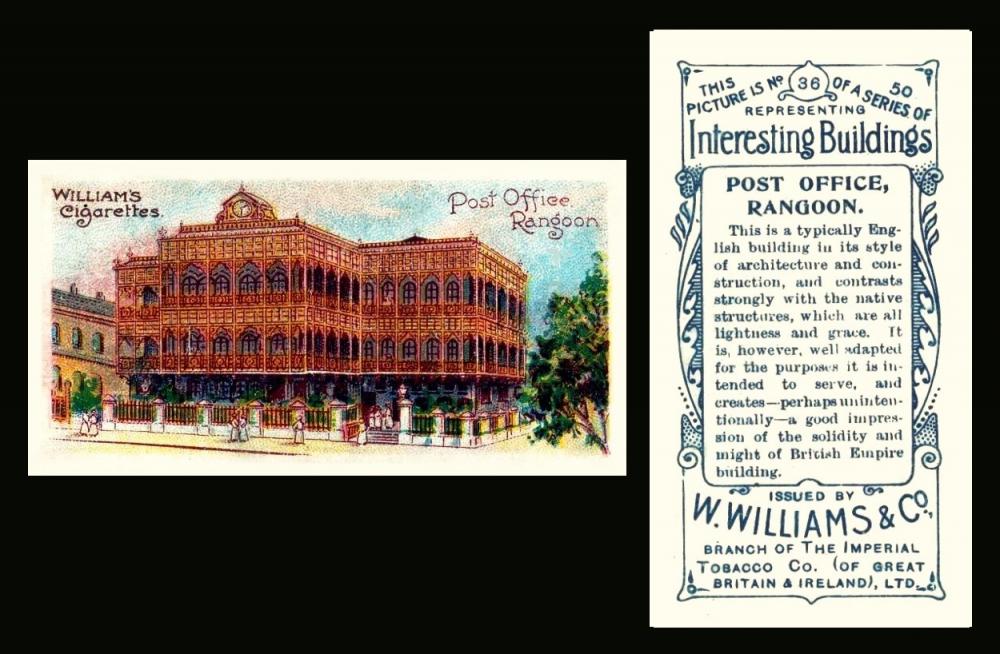
W. Williams & Co. [tobacco : UK] "Interesting Buildings" (1912) 36/50 - W650-340 : W60-5 : H.70
Now here is an interesting idea and an "Interesting Building" for today is National Send a Card Day. The idea is that we are supposed to send a card, perhaps even a postcard, to someone we know, or would like to know better. But this could equally be used as a prompt for us to put our favourite card of the moment on social media and send it out into the world. So why not join in?
Here we have the Post Office in Rangoon. I am not sure whether any of our readers have friends in Rangoon or whether the building brings back any memories but looking at it is quite amazing, and the scale of it is enhanced by those little tiny figures below. And even more amazingly it is still there, though not so brown, have a look at General Post Office Yangon for more gen.
This is a different version of the "Interesting Buildings" set which was also issued by Churchman and Hignett in July 1905, Stephen Mitchell in 1905 (no month seems to have been recorded), and Wills, with Capstan brand in Australia in 1905. Our set was issued much later in 1912.
W. Williams was based in Chester and is notable for being a founder member of the Imperial Tobacco Company.
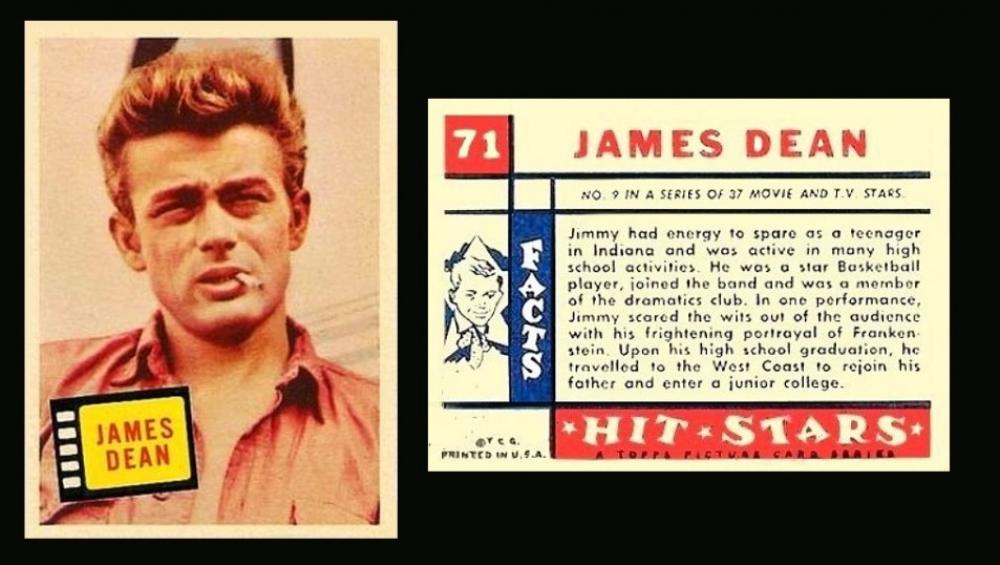
Topps [trade/commercial : O/S : USA] "Hit Stars" card 71
So today we celebrate the birth of one of America`s most iconic stars, who never had the chance to show us how great he could have become. James Byron Dean James Byron Dean was born today, in 1931, in Marion, Indiana. His father was a farmer who had somehow changed profession and become a dentist, or in some cases just a dental technician.
His mother died when James Dean was young and he was sent away to an uncle, to a farm in the same state. He moved to New York as soon as he could to try and become an actor, and though he had few roles the ones he did got the attention he needed for him to move to Hollywood in 1951.
He started as an extra, but again caught the eye of those who mattered and was given a part in "East Of Eden" in 1955. The same year he developed his brooding bad boy persona with what many believe his greatest film of all, "Rebel Without A Cause". His third film was "Giant", but he never lived to finish it, for he was killed instantly when his car hit another vehicle on September 30th 1955.
After his death it was discovered that he had received a speeding ticket a few hours earlier that same day.
He was just 24 years old
During his lifetime he appeared on not a single card. The first ones issued were what are usually known as Dutch Gum cards, but they date from 1956. On some of them you will see the word "Jatten" and that, poignantly, is Dutch for "Giant". Sometimes it has the initials W.B. for Warner Brothers as well. Our card dates from 1957 and it has a very curious numbering system for card 63 is also said to be card 1 in a series of 37 TV and Movie Stars. This is because the first sixty two cards are "Recording Stars", in other words singers and musicians. James Dean appears on several cards, starting with no.63, namely 63, 65, 66, and 71, all with a very soulful biography that emphasised his loneliness. He seems to have had plenty of friends but never seems to have found the one who made him complete, or maybe he did and never said. Some people manage to keep their privacy intact, and to me that makes a person all the more special.
In the early 1990s he seems to have been rediscovered by card issuers when he appeared as part of the Starline "Hollywood Walk of Fame" series. This led to a few more commercial issues, and even, in 2007, to some which included pieces cut from the clothes he wore, many of these being Donruss "Americana", "Hollywood Legends" and "Celebrity Cuts". Though other companies now also issue cards with sections of clothing inserted into them as well. I have to say this is a very odd thing to me, though I often see them as I hunt through eBay looking for science fiction memorabilia before I go to sleep.
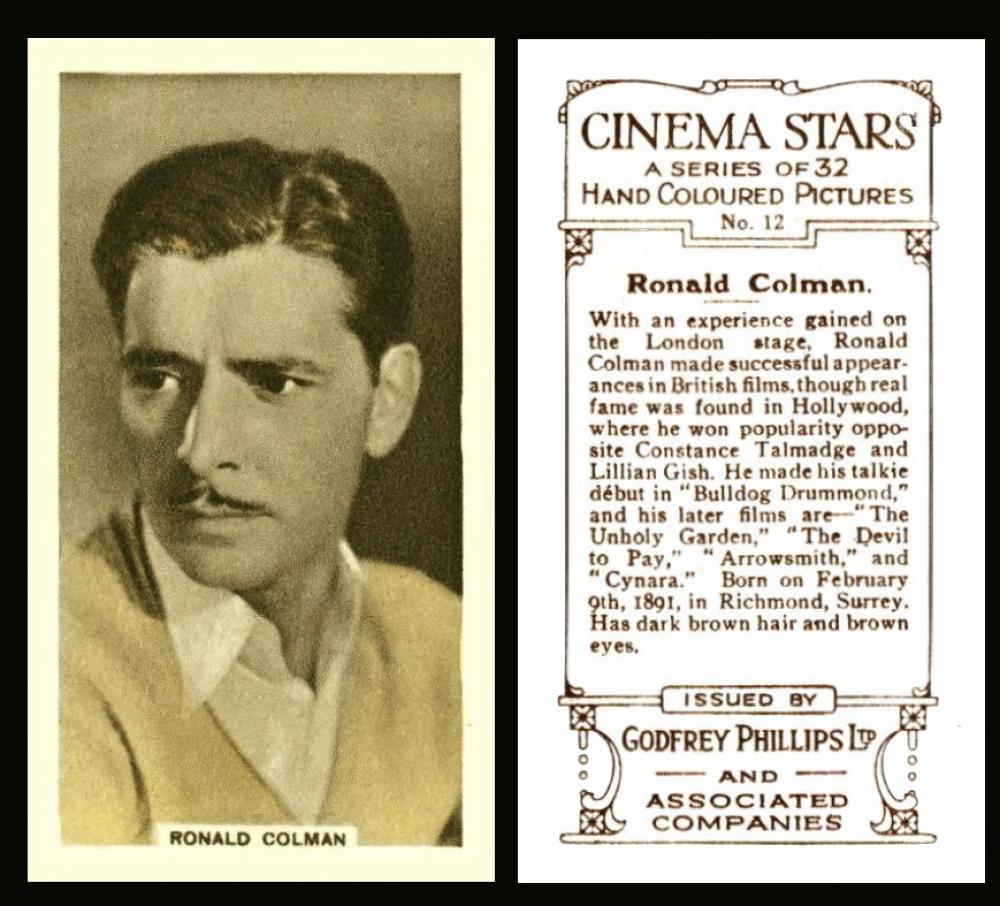
Godfrey Phillips [tobacco : UK] "Cinema Stars" hand coloured (1932) 12/32 - P521-428 : P50-101 : RB.113/54 : RB.13/54 :
Ronald Charles Colman was born today in 1891. Many cards will tell you that he was born in Richmond in Surrey, but none that his father dealt in silks. The materials not the cartophilic items! It was whilst he was at boarding school that he first appeared on the stage, and he enjoyed it. He hoped to go to Cambridge after, but that was not to be for his father died, and relatively shortly afterwards the First World War broke out. He joined the London Scottish, which must point to at least one of his parents being Scottish, and he was sent to France very early on, but he only served there for two months, during which he was wounded in the leg, quite seriously, and also gassed. There seems to be contradiction in the location of these incidents, one says Messines Ridge, another Ypres. If he was only wounded at either of these battles he was very lucky indeed. But gas was used at both, which adds to the confusion. The gas had lasting effect for he suffered with lung trouble ever after for all his life and it was eventually a contributing factor in his death.
He planned to find a job somewhere overseas in the Civil Service, but whilst he was looking for it he was offered a very small part on the London Stage. He took it to help with his expenses, but it rekindled all the affection he had found for drama at school and he stayed on, moving into films, and then leaving England for New York in 1920. Again it was the stage that welcomed him first and led to him being spotted for a new movie called "The White Sister".
One unusual card of him shows him in a cowboy hat, that is Societe Job "Cinema Stars". Sadly the cards are without descriptive text, and I have not yet found the film. He looks good as a cowboy though! The pictures used on this set credit "Cinemagazine", which was a French film magazine, and they issued postcards, so it is very possible that this image also appears on one of those.
He took easily to sound films; Ardath "British Born Film Stars" tells us his first talkie was "Bulldog Drummond", and he was often cast as the very well educated and thoughtful kind of leading man that so seldom appears in movies today. But he could also play handsome heroes like Sydney Carton in "A Tale of Two Cities" (Carreras "Film Favourites" 4/50 and two sets by Godfrey Phillips, "Famous Love Scenes" 2/36 and "Characters Come To LIfe" 7/36) - or Francois Villon in "If I were King" (Stephen Mitchell "Stars of Screen and History" 6/25)
His private life was seldom in the news but he married twice, and had a daughter. He died in 1958.
Our card is described in the original Godfrey Phillips reference book (RB.13) as having "fronts in sepia photgravure, hand coloured. Backs in brown. Matt photos". It was also issued by two other companies, these being Abdulla in a glossy format (but with exactly the same back design and text) and United Kingdom Tobacco in a matt format. It was issued by United Kingdom Tobacco first of all, in 1933, and by the other two a year later
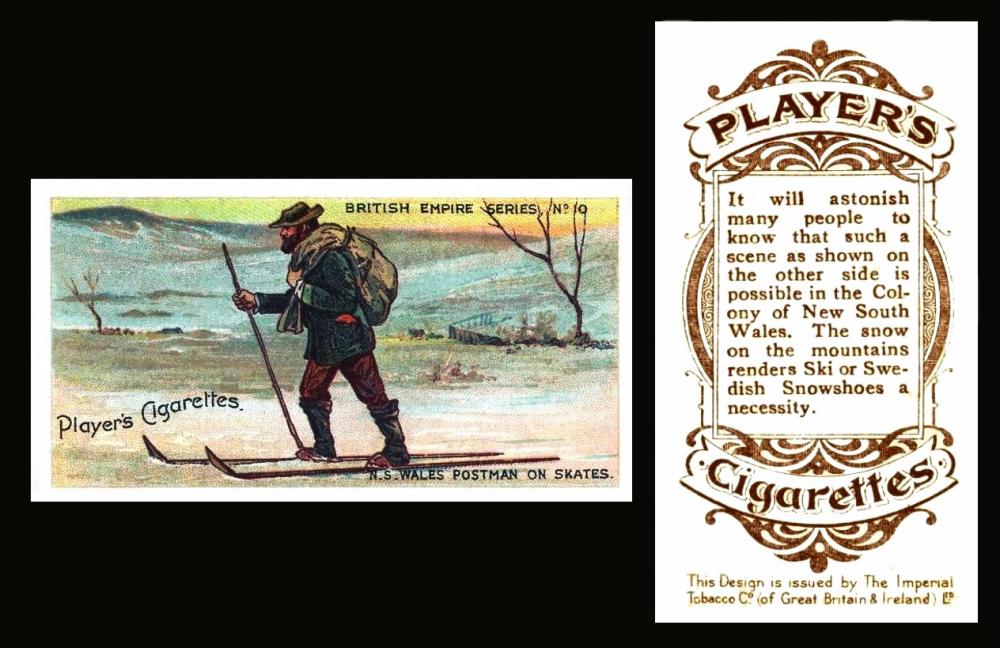
John Player [tobacco : UK] "British Empire Series" (1904-1909) 10/50 - P644-046 : P72-18 : RB.17-32 : H.343
And so we close our diary with this card, to celebrate the work of the International Ski Patrol. Now today the firm Helly Hansen will be donating a proportion of their profits to that organisation. And they also supply their clothing to ski patrols. So if you need a winter coat or some more skiing equipment you know where to shop.
You may be wondering what a postman has to do with the International Ski Patrol? Well in its most basic form any kind of patrol is someone who knows an area well, where it gets icy in the winter, and where the rocks are barely below the surface. They also get to know the people who are about them, and take special notice of anyone who seems to need extra help. All those things could be said equally of our man, delivering his post, on his skis....
Or is he. Because if you look closely at this card it says he is on skates. And this was an error. The picture from which this card was taken included the description of him being on "Skaes" so of course the typesetter, or his assistant, thought that it must be an error, and that the T must be missing to form the word Skates. So he slid it into the housing and printed the card. However in the regional dialect, and presumably this was Scandinavian, a Skae was actually a ski. This links in well with the fact that the back of the card mentions "Swedish Snowshoes". But I am no closer to finding a link with Sweden and New South Wales. Any ideas?
This card was issued by John Player in many printings and there are loads of errors. We think it was in circulation from 1904 until 1909, so some of the printings would have been done to keep up with supply. It was also printed on both a greyer board with matt fronts or a white semi glossy board. And it was also issued by W.D. & H.O. Wills overseas at around the same time, in Capstan, Havelock and Vice Regal brands. There is also a set of anonymous cards which are presumed to have veen issued somewhere by British American Tobacco.
This week's Cards of the Day...
have been looking a bit further ahead and celebrating Rugby, or more specifically, the Six Nations Championship which starts on Saturday February the 4th, with two matches, Wales vs Ireland - at the Principality Stadium in Cardiff - and England vs Scotland - at Twickenham. It ends on the 18th of March.
We have included two sets that we had before but as football, not rugby football, so it is interesting to be able to compare them. In fact it is rather odd that football sets should still include a mixture because football and rugby started to split off in 1863, and by the 1870s they were far apart. Many people believe that the fact that football expressly forbids carrying and handling the ball is because they wanted no remnants of the mixed game to survive.
Saturday, 28th January 2023

This clue referred to the first match of the Six Nations Championship, which is being played at Cardiff. And the kick off is at 2.15. But also it refers to the fact that Wales was the first winner of the competition in 1893, its first year. However at that time it was not called the Six Nations, mainly because only four nations took part, these being England, Ireland, Scotland, and Wales so it was called the Home Nations Championship. And though none of these teams were really that international, the event has gone down in the record books as the first International Rugby Tournament. It continued until 1909.
This set was issued with “Chums” magazine. And that is how they are listed in both our British Trade Indexes. However "Chums" was not an issuer, but just a magazine, that ran between 1919 and 1925, it was actually published by Cassells.
This set was issued a card a week, and we do have week dates for some of the cards, but not all - not this one either. They are described in our British Trade Indexes as being black glossy photos, measuring 70 x 45 m/m, numbered, and a set of twenty cards. There is also a "New Series" which was issued in 1923, but only seems to have been eight cards, and of a smaller size, 60 x 35 m/m.
Sunday, 29th January 2023
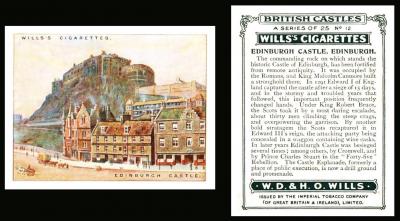
So here is our card for the next match, England vs Scotland, which is the same day. The Scottish home stadium is Murrayfield, which is in Edinburgh, but almost three miles from this castle. However they will not be playing their England vs Scotland match there, but at the England Home Turf of Twickenham.
This set first appears in our Wills Reference Book part four, where it says "25 BRITISH CASTLES large size, 79 x 62 m/m. Fronts printed by letterpress in colour. Backs in grey with descriptive texts. Home issue 1925."
We get the month of issue later, when these long out of print booklets are reprinted in a volume containing all five, for that includes dates of issue for home and overseas sets, as extracted from the Wills Works magazines.
Looking at the set, you find that the castles are in alphabetical order, starting with 1. Alnwick in Northumberland, and going through to 25. Windsor in Berkshire.
Monday, 30th January 2023
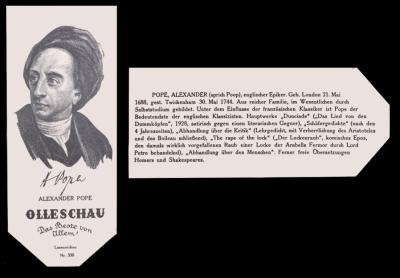
This is rather an intriguing item, and you may think it only borderline cartophilic, especially as the company that issued it did not make cigarettes, only cigarette papers in which you could "roll your own". However we know that in the 1930s this company did also issue very thin, papery cards, showing scenes of places, so far we have found "Austria", "France and Monaco", and "Germany", and they also produced special albums in which the "cards" would be stiuck, these were hardback, like photo albums, and had a rope tie fixing them together.
Now Olleschau is actually the German name of this little town in the Czech Republic. And today the largest company, and biggest employer, is still the cigarette paper factory which was founded in 1862.
I have already had quite a bit of response about this set. Apparently all the German
catalogues give the company as being sited in Vienna. Several collectors were therefore quite intrigued that we had managed to find the town of Olleschau. The problem seems to be that this is one of the borderlands which changed hands between the neighbouring countries on a regular basis, and was often renamed as a result. It also does not help that the address was never given on their packagings, which seems odd from an advertising point of view. However some cards do mention the company of Altesse, in Vienna, and we have been supplied with a link to their history-page. There is also a thought that Olleschau may have been a brand name used by Altesse.
Returning to the bookmarks, if you look at the bottom they say "Lesezeichen" which translates literally to "read mark" and therefore book mark.
We also know that there are at least a thousand different ones, so the list I thought I would make has been shelved. Quite a lot of them can be seen online though, at various European internet auctions, and at zvab.com/lesezeichen+olleschauer
Now the connection with our theme of the week is that this item shows Alexander Pope. He was born in London in 1688, and in 1719 he moved to Twickenham - which is the site of that England vs Scotland match. Now when he got to Twickenham he set about changing the landscape of his garden in many ways, even adding an underground grotto. The Villa became known as Pope`s Villa, and it was a bit of a tourist attraction.
However, in the early 1800s another person bought the house and, as most people do, even to this day, she tore everything out, put it in a skip, and started again. This was the Baroness Howe of Langar, and she also decided to demolish the famous Villa and had a mock Tudor house built instead. Now, we must not be too unkind, because she decided to keep the grotto, and that still exists today. It is also sometimes open to the public, but the house is now a school so visiting is limited.
Tuesday, 31st January 2023
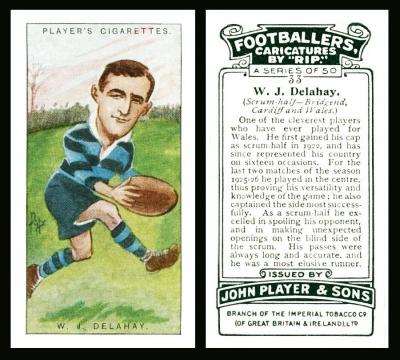
This set has been on show before but it is here to demonstrate that "football" was often used interchangeably to mean Soccer and Rugby. So here we have a Rugby player, W. J. Delahay, representing Welsh Rugby.
He was born on the second of September 1900, and his initials stood for William James, though oddly he was often referred to as Bobby. He played for Bridgend first and then for Cardiff, as a scrum-half, though when he played for Wales he was often either a fly or a centre, as he was in 1924 against the All Blacks. Cardiff lost but by all reports it was an excellent match. Whether through this performance, or not, he was Vice Captain of Cardiff R.F.C. for the season 1925/26, and Captain for the following.
His first Five Nations Championship was in 1922, and Wales won. The following year they were last. He did not take part in 1924. However he was again selected in 1925, and 1926, during which he served as Captain in the final game against France. In 1927 he left Cardiff and started to play for Torquay Athletic, basing himself down in Devon, and was there for about ten years. That brings us up to the start of the Second World War, and there the trail goes cold. However he must have survived because he died in September 1978.
Our original John Player Reference Book RB.17, published in 1950, tells us that this set was of "Small cards. Fronts in Colour. Backs in grey with descriptive texts. Home issue. August 1926."
That means that this set was actually issued before the "Football Caricatures by MAC", for that was not issued until September 1927. Maybe that is why the MAC set is more known and more plentiful.
Our World Tobacco Issues Indexes are much more short and not so sweet - and just say "Sm. Nd. (50)"
Wednesday, 1st February 2023
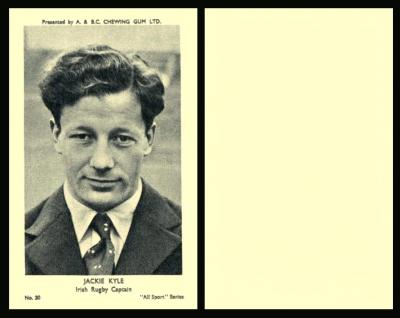
The subject of today`s card, "Jackie" Kyle, was born John Wilson Kyle, in Belfast, on the 10th of February, 1926. And why he is here is because he led Ireland to not just a victory but a grand slam in the 1948 Five Nations Championship, during which Ireland beat every team it played against.
Now there is a curious fact here, because why the event was called the Five Nations was because France had joined in - in 1910. However in 1931 it was discovered that some of the French players had been paid for playing, not in the championship, but with their home teams, and this led to France being banned from the Five Nations event. Because of this it again returned to being the Home Nations Championships again. They were given an eight year suspension, which ought to have seen them return in 1940, but the event was cancelled for the duration of the Second World War and did not start again until 1947.
Returning to Mr. Kyle, he not only represented his country, he was part of the British and Irish Lions, and the Barbarians. And in 1950 the New Zeland Rugby Almanac declared him one of just six Players of the Year. More than that, in 2002, he was stated, by none other than the Irish Rugby Football Union, to be the Greatest Ever Irish Rugby Player.
One thing that many people do not know is that he not only trained to be a doctor, in Belfast, at Queen`s University, which was where he first played rugby - but that after his retirement from club rugby in 1963, he was heavily involved with humanitarian work in Indonesia and Sumatra, and was even a consultant surgeon in Africa, for over thirty years. Then he returned to Ireland, and died in November 2014, aged eighty-eight.
Despite all these things, it appears that apart from this card, Mr. Kyle seems to have only featured on one other, and that was as part of the 1968 set of "International Rugby Greats 1948-1968", generally regarded to have been issued in 1968 by Playtime Gum. However that was not an issuer, it was just a brand - circulated in New Zealand by Allen & Regina, of Oamaru, New Zealand, which, according to my original Australian and New Zealand Index, part one, was "89 x 63. Grey-black, blue and orange framework. Back with sectional picture, some sections with parts of red overprint of Scanlen`s "Twin" trade mark. Nd. (?40). We now know that there are indeed forty cards, and the sectional picture makes up to a rather frenetic rugby scene in black and white. As for Allens & Regina, that was formed in 1970 to distribute gum cards issued by Scanlens, Donruss, Topps, and A. & B.C. Gum - though sadly this arrangement came too late for them to handle our set !
Back to our card, as you may be wondering why it is plain backed. The answer is that it was designed to be stuck in an album, above the text which was printed there. Thanks to one of our readers, Mr. Coates, we know know that text actually read : "(Irish Rugby Captain) Match Winner of the / outstanding post-war Irish International Rugby / team, Jack is reputed to be the `greatest out- / half of all time`. He is a magnificent oppor- / tunist and tactician in attack, and safe in defence. / He has won many International Rugby caps for / his country since 1947.
We still have a query remaining though, and that is can anyone can explain why the album is reputedly available in two formats - with blue pages or with grey ones - was one of these a second edition, when stocks ran out?
Anyway, the album was advertised on the packets, with the offer to "Send 1/- and only 5 coupons for your super giant 20 page album containing a full history of all the sportsmen and sports women in this series". The coupons were part of the waxed packet, and had to be cut out, which is why the wrappers are now so scarce - but you can see one for yourself at TCDB/AllSport/packet. And whilst there they also list all the cards in the set - at TCDB/All Sport/Lists. Before we walk away from the packets, they raise an interesting fact, as this means they must be from the very early second stage of the A & B.C. Gum issues, as their first cards were actually sold from vending machines, you inserted your coinage and out came a ball of gum from one slot, and a card from the other. Now we know that the vending machines were still operational in the 1960s, but this set, with its packet, with cards and the gum, pre-packaged, was issued in 1954. So it looks like this set may have been part of a trial run of getting shops to stock cards in packets.
Now to the card chat.
If you look in our original British Trade Index, published in 1962, you will get confused, as the first set in that is A.B.C., but not our A.B.C., instead it is "Associated British Cinemas", who issued film star cards between 1935 and 1936. The reason for this is because the title of that original British Trade Index is actually "Cartophilic Reference Book - No.25. Index of British Non-Tobacco Issues up to 1945 ("British Trade Index")
A . & B. C. Gum first appear in part two of the British Trade Index, published in 1969. Their entry starts with a short piece about the company, which reads :
A. & B. C.
American & British Chewing Gum Ltd. Subsidiary of Topps (U.S.A.), many series by A. & B. C. are similar to or based on Topps issues in U.S.A. Cards issued 1953-68. See Anonymous Sets ZB10-2, ZG4-11, ZG9-1, ZJ8-7.2, ZJ9-1, ZJ9-4, ZJ9-13, ZJ11 sets, ZJ12-1, ZJ12-3, ZJ12-4, ZJ12-7, ZT7-1.1
- "ALL SPORTS" SERIES. Md. 76 x 47. Black. Nd. (120). Album issued. ... ABF-1
The original British Trade Index became a part work, of four parts. Then, in the year 2000, it was updated, and re-published as a single volume, plus a handbook, to which the lists of cards were removed.
The listing in that for our set and also the header about the company does vary, and the full text is
A. & B. C.
American & British Chewing Gum Ltd. Subsidiary of Topps (U.S.A.), many series being similar to, or based on, Topps issues in U.S.A. Issued 1953-75. Includes U.K. brand issues of Bubbles Inc., Brooklyn, U.S.A., and brand issue "T.C.G." Some `stickers` set details are omitted, for example Hip Patches (200), Military Silk Stickers (215) and Tattoos (number unknown). These are of different shapes and sizes, many without caption.
- "ALL SPORT" SERIES. 1954. 76 x 47. Nd. (120). Black. Album issued. Cards a) glossy, b) matt ... AAB-020
Before I move along, there are a few things from these listing that need to be discussed.
Firstly, there is no basis to the initials standing for American & British Chewing Gum, though it appears in both these works; it is a bit of an urban myth, though, with the Topps connection, and the American nature of many of the cards, it is easy to see how collectors heard it and believed it to be so. The truth is that it was named for the initials of four men, Simon Aynsz, Rudy Braun, and Douglas and Tony Coakley, whose wartime service had come to an end. They started out by planning to call it "A.B.C.", but there were lots of companies using those initials, so they simply inserted the ampersand.
If you would like to learn more about the company, nip along to Cardhawk/ABC - which was chosen because it scrolls down to show a great many of the football cards that they issued.
Secondly, and I have checked, the name of this set is indeed entered wrongly in our original British Trade Index part II, as "All Sports" Series - as the cards do say "All Sport", in the singular.
Thursday, 2nd February 2023
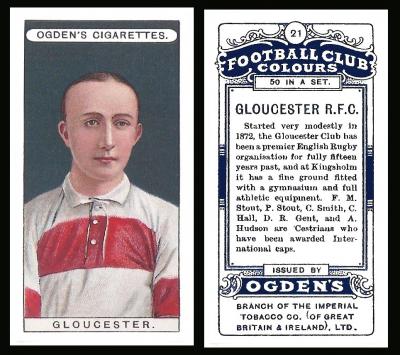
The first thing to note here is that this set of "Football Club Colours" include Rugby too, eleven of them, and we have one of those clubs here.
This card mentions "internationals" on the back and though it is not mentioned, the internationals were the Home Nations and Five Nations Championships. Percy Stout and Frank Stout played in the 1898 Home Nations Championship, being chiefly remembered for both scoring tries in the same game, England vs Wales, a fact which would not happen again until Tony and Rory Underwood managed it almost a hundred years later in 1993. C. Smith has not yet been tracked down. Nor has C. Hall. But D.R. Gent turns out to be David Robert, or Dai Gent, who was in the 1910 Championship, by then called the Five Nations, for France was playing. And Arthur Hudson was in the 1906 Home Nations Championship. He took part in the opening game, England vs. Wales, on the 13th of January - and scored a try - as well as playing for England vs. Ireland on the 10th of February.
This set is catalogued in our original Ogden`s reference book (RB.15, published in 1949, as :
86. 51 FOOTBALL CLUB COLOURS. Fronts lithographed in colour. Backs in blue, with descriptive text; cards are known with backs very dark blue, almost black. Cards Nos. 1-50 are inscribed "50 in a Set". Card No.51, inscribed "51 in a set", represents the Captain of the South African Team in England for the season commencing autumn 1906. The latter card seems to have been added after preparation of the series of 50. Home issue 1906. Similar series issued by Churchman and Franklyn Davey.
These two other versions, just like our Ogden`s version, were produced by Mardon, Son and Hall. However they were issued a bit later, both of them arriving in the packets in January 1909, and neither of them have that additional fifty-first card -presumably because it was a topical extra, and, three years on, it was all forgotten.
The backs of the three versions of this set are different: the Churchman looking the same as Ogden`s, and being numbered identically, but being printed in brown, and the Franklyn Davey being neither numbered nor descriptive. The Franklyn Davey set is also the most valuable, probably simply the fact of supply and demand, those cigarettes being less easily obtainable than the others.
The Churchman cards were definitely the easiest to acquire, and they were also the first to be illustrated - in Cameric Notes and News, Vol.1, issue 6 and Vol.3 page 90.
In the London Cigarette Card Catalogue of 1950 the Ogdens version is split into a set of fifty cards, retailed at between 1/9d and 5/- a card for odds or £12 a set, and then a separate line for card fifty-one which was available at 10/-. In comparison the Churchman set was retailed at between 4/- and 12/- a card for odds or £30 a set, and the Franklyn Davey at between 4/6d and 15/- a card for odds or £37 a set.
Friday, 3rd February 2023
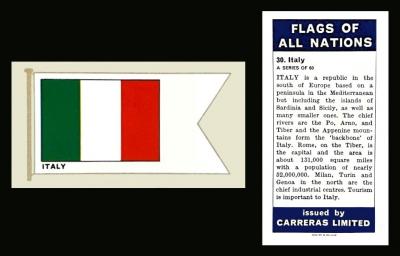
This is an unusual card and well done if you got it. It was printed in Belgium some time in the 1960s and intended to be issued through Carreras, possibly in Europe, but though sets were produced they were never issued. It measures 66 x 35 m/m.
The reason it is here is because the sixth of the Six Nations is indeed Italy. They seem to be universally known as just "The Italian National Rugby Team", though some people call them "the Light Blues". Italy first started to play rugby quite late, and it appears their first international were inter-Europe matches, in 1911, which led to them being formed into a federation later in the same year. However they did not make their first appearance in the newly named Six Nations until the year 2000.
If anyone knows of any Italian, or for that matter French rugby cigarette card do let us know. Reputedly there are only two French rugby player cards out there, which you can read about at RugbyPioneers
And there you go, another week is passed. I hope you enjoyed it, and that it brought you many cards and many pleasures. I have not had a lot of time for cards this week, but somehow I have managed to get all the codes up tonight, which is rather a miracle for me. Because of that I will be able to add any updates to the body of this text via the "Whats New" Blog, so check for that to pop up to the top of the newsfeed column.
And if you only just discovered us, welcome. You can read last week`s newsletter, if you missed it, at
https://csgb.co.uk/publications/newsletter/2023-01-28
Now I would like to close by thanking everyone who gets in touch with me. I much appreciate the help you give to the newsletter, by providing scans of cards and extra information, and also corrections, for sometimes they provide the missing link that sets my ship on a whole new exploration. And it is very special indeed to hear that someone has enjoyed the little things I gather together and turn into writing, and even more so that they have taken the time from their own busy schedule to get in touch and tell me.
